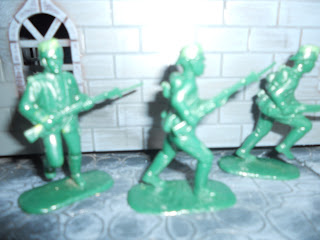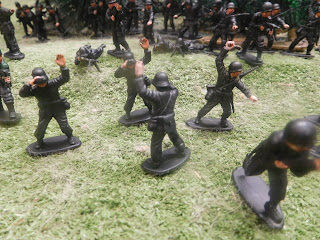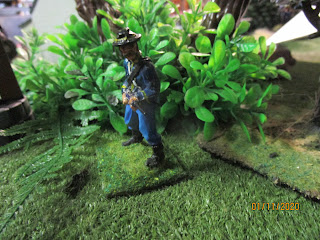Imaginations I Have Known & Wargame Scenarios
Priestess, sorceress, witch, queen, exotic dancer - take your pick.
Ozzz Munchkin cavalryThe Wizard of Ozzz (converted Winston Churchill)
Harpies await their victim. (They attacked the Amerigan plane.)
The short answer to what is an imagination is that it is an imagined land. Literature is full of them, some lending themselves to wargames more than others. Wargamers who use imagi-nations might go into great detail about dynastic struggles, economy and history as well as military capabilities. Alternatively, they might just have a very basic setting, usually set in a real historical era and have fictionally uniformed armies. Another possibility is a land with many SF or/and fantasy attributes. It might even be set on another planet. My imagi-nations vary immensely and I don't place many limits.
CHILDHOOD
My childhood was one of a vivid imagination, fostered by television with its Westerns, historical dramas like Robin Hood, SF shows like The Time Tunnel, Doctor Who, Star Trek and so on. Then there were the hundreds of comics I read. There were comical ones like Sad Sack and Disney. Mickey Mouse and Donald Duck, with various nephews and uncle travelled all over the world and there was a Micky Mouse tale where he ended up in a fictional European land where he took the temporary place of the prince - based on Prisoner of Zenda which was set in Ruritania. Others, like Tarzan and Flash Gordon had Lost Lands in the jungle and a whole planet with its own geography and invented nations.
Toy soldier battles figured strongly in my childhood. Generally, they were kept in their time periods of mainly Western, ACW and WW2 but the small number of British ceremonials, plastic and metal, sneaked into both my ACW and WW2 games. A handful of AWOI also sometimes ended up in my ACW games.
In my junior years of Technical School, I made up, for English, an illustrated map of a fictional world. I still have it somewhere and will post it one day. However, I did not, then, translate fictional lands into my wargames.
SOME INSPIRATIONS
I have always read a lot of SF and some of the ones I really enjoyed had the premise of parallel universes. One of these had an Earth where the North American continent did not exist but was a series of islands. The author, who I forget, went into a great deal of detail about uniforms and weaponry. They were basically late 19th century. The firearms were vaguely familiar but different.
Influenced by my students, in the 1990s, I entered the world of Warhammer 40K with its numerous alien civilizations and interplanetary human empire. Among the things I really liked were the tanks that seemed to owe much to both WW1 and WW2 designs. The legacy is I am intrigued by totally fictional tanks and occasionally use my own designs in my 1/32 games and notably steam tanks.
Major turning points for me were reading articles in Plastic Warrior about the imaginary countries of Frank Perry, his pal Ken and son Ross. These included Caspia and Rossland. I liked how different nations were at different historical levels so a WW1 level army could fight Romans or cowboys and Indians. The technologically inferior armies had to be very clever to cope. This was influenced by what actual toy soldiers frank, Ken and Ross had.
Tony Bath's Campaign Wargames was another influence with his land of Hyboria where many civilizations met, even those who never actually did.
Another major influence was Padre Paul Wright's Funny Little Wars with its color-coded armies continuing the influence of HG Wells, Little Wars.
IMAGINARY NATIONS IN MY WARGAMING
I'll start with Paul Wright's late Victorian/Edwardian armies. I haven't used all his army lists but I'll mention the ones I have.
First off, the following are obviously based on historical nations and I have used them all:
Redia (Great Britain)
Army Black (Prussia or Germany which I also call Hermany)
Army Dark Green (Russia which I also call Crussia)
Army Light Green (The Balkans which I also call Trans-Slovania).
Army Red White and Blue (America, which I also call Ameriga)
Army Lime Green North or South (Mexico which I also call Cortesia)
Army Khaki (Ottoman Turkey, which I also call Fezia)
Army Horizon Blue or Blusia (France)
Army Cerise (Japan)
Among other semi-historical armies Paul lists are based on Austria-Hungary, Italy (Army Red White Green), Spain (Army Red Gold) and Belgium (Army Purple), Army Red yellow Blue (sweden)) and Army Red White (Switzerland) but so far, I haven't fully gathered armies for those nations.
Paul also made lists for Chile and the Boers.
In addition, Paul listed two other nations not based on real ones:
These are: Ruritania, a small nation from a novel, Prisoner of Zendar.
Gerolstein, from an opera.
I have armies for both those nations although I borrow some troops from my ACW and Napoleonic armies.
I have added additional armies for this period:
Lionia (Abyssinia)
Zoohoo (Zulus and Arabs)
Grand Fenwick (from the Mouse that Roared but unlike the book not set in the 1950s)
Barsoom (From John Carter of Mars).
Confederacy late 19th century (I haven't used this one yet but it is inspired by the novels of Harry Turtledove)
The fun part is compiling lists and then dice rolling to decide who the combatant nations are.
WHY?
My main reason for liking fictional nations is they are an additional creative outlet. Also, even those, partially based on real nations give me an excuse to include fictional uniforms and to combine some troops from a few decades apart.
I also like inventing characters, leaders and places.
Some people feel they need to justify to historical wargamers their imagi-nations approach to wargaming. My observation is that 'historical wargames' are not necessarily historical. Usually, gamers set up two opposing amies of equivalent strength and fight across the board until attrition wears out one side's army. The points are also then added up to decide the winner and by how much. Real battles are rarely fair and even matches.
Also, the uniforms are spick and span and often the dress uniforms with nary a patch or splash of mud. (Not that I mind that, I used to splatter my troops with paint dust and add patches, and so on. I still do sometimes but I also like the spick and span parade ground look).
Personally, although I have played many 'historical' games I have rarely played ones that attempt to replicate real battles. I did, admittedly, once play First Bull Run on my driveway, complete with cheap Wild West train moving Confederates across the field and a blue uniformed Confederate regiment getting close enough to the unaware Yankees to blast them. So, yes, I sound a bit contradictory there, but I see no reason not to enjoy a wide range of wargame situations.
Most games, though have been generic with a hill here, a town there and objectives to either inflict the most casualties or to capture an objective. That is fine and enjoyable, but it is not an exact reproduction of a historical event.
I keep a foot in both doors as most of my imagi-nations countries have historical troops. Thus. I can use them for more historically themed games or fantasy.
ANGRIA, GLASSTOWN & THE BRONTES
Angria is a cool name and it comes from the Bronte sisters (and let us not forget the brother) when they, in the shadow of the Napoleonic Wars, and as children, created their own imaginary world. The Man of Tin blog often features references to creating armies for their world.
BOGAVANIA, BEERSTEIN & FEZIA
Now I come to my 'fantasy' games. In one sense all wargames are fantasy but some more so than others. Since 2012 my wargaming pal, Mat, and I have been playing campaigns that were originally mainly medieval but are now late 18th century to early 19th century. However, we still have the options, in our points lists to use earlier troop types, including knights and in Beerstein's case, crusaders. Longbows are still useful although expensive. Then there are wizards that did not just fade away but can still be bought. in addition, there are non-human nations and other human nations at earlier periods of technology. Our campaign is a merger between word and Sorcery and historical type troops.
One of the advantages of having secret map moves is that the resultant tabletop battles can be very unexpected in army compositions and often the armies are very unequal. Rather than simply point counting to see who 'won' the importance of the battle is how it links with what is going on in other hexes. Often an army retreats to survive to fight another day and 'objectives' in a particular hex are less important than what is going on elsewhere. However, if we want to decide who won we count the number of units destroyed or driven off or if an army has accomplished an objective. That might be just surviving, if it is a much smaller one. We don't usually really count how many individuals have been killed.
THE WORLD OF OZZZ
I have always been a big fan of the Wizard of Oz. A few years ago, I discovered 'Wars of Ozz' which explores the angle of Napoleonic armies, creatures and witches. I have my own version which I call Ozzz but using 1/32 figures and my own rules, although I do borrow the rules for spell casting.
Below, Fezian matchlock men on the paint table. The uniform was inspired by an Indian one.
Ozz verses AmerigaAmerigans kills the last of the huge Ozzz lions that attacked them from a cave.
The giant was imposing but not bulletproof.
The Good Witch
The Bad Witch
Teddy finishes off the giant.
Don't forget the civilians.
Hovels
South American cavalry that double as Gerolsteiners, Blusians and others.
Patrans (Romans, obviously) metal copies of Timpo
Gerolstein machinegun with flags from The Virtual Armchair General
Timpo Napoleonic infantry doubling as Ozzz troops
Fezian plate armored cavalry
.JPG)

.JPG)
.JPG)





.JPG)
.JPG)

.JPG)
.JPG)

.JPG)











Informative and nice summary!
ReplyDeleteThanks for sharing James
I like the 'colour coded' armies. My own 'Chromatic Chronicles' are as inspired by H.G. Wells's 'Little Wars'.Though I have only a limited range of countries, their armies are fairly sizeable:
ReplyDeleteRuberia (RED) - sort of UK (Kingdom + Empire of Sangria)
Azuria (BLUE) - sort of France (Republic)
Turcowaz (TURQUOISE - other Blue) - Settee Empire
Izumrud-Zeleniya (Emerald Green) - sort of Russian Empire
I do have a shadow 'character'
Grauheim (GREY) - sort of Germany.
All four belligerents have navies - pre-dreadnought - of which the Ruberian is the largest. These navies are almost complete - just one battleship to be built for Izumrud-Zeleniya, and a possible armoured cruiser for Ruberia.
At the moment - 1884 - there are political murmurings that seem likely to lead to war: the 'Blues' against the other two. I have yet to determine the theatres of war, and how the pairings connect. Ruberia has the largest forces available, but more commitments, so things could get interesting.
I'll be posting stuff about these forces, I hope sometime soon)
Cheers,
Ion
I like the names, especially, Ruberia. What scale will the games be in? James
ReplyDeleteI guess my UN troops are kind of 'imagination' as well, as they can represent a lot of different countries. They're only identified by a generic blue helmet. Therefore I guess I can also deploy them in fictional missions in other 'Imaginations'?
ReplyDelete